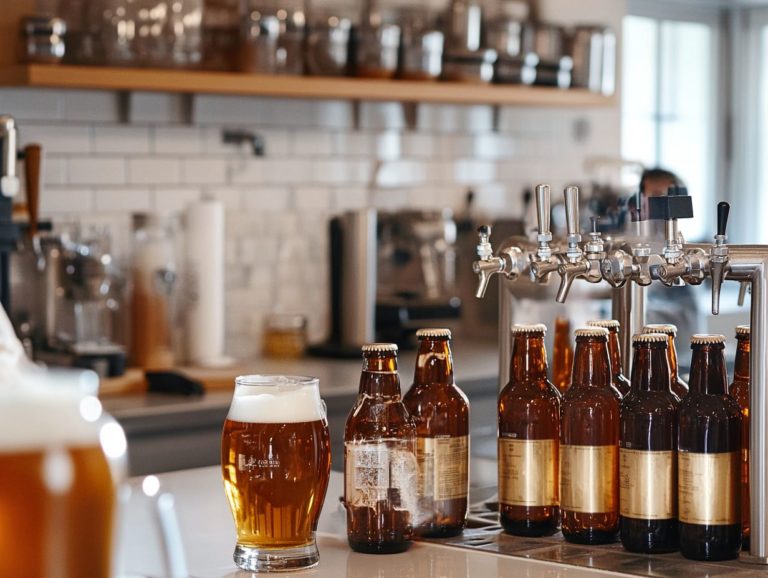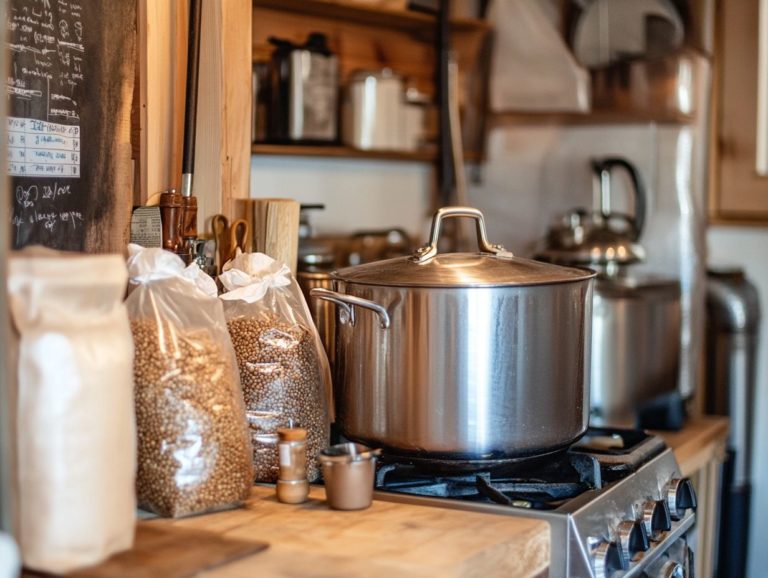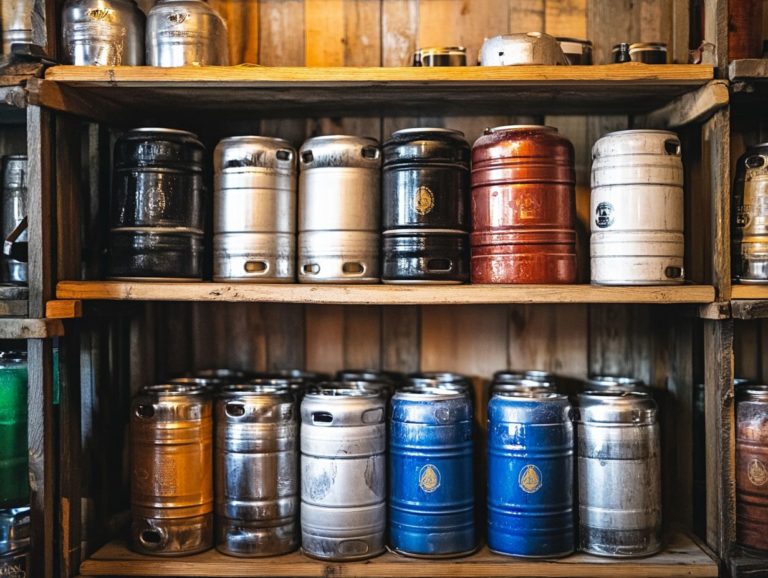How Do I Create a Brewing Schedule?
Crafting the perfect brew is as much an art as it is a science. Establishing a solid brewing schedule is essential for achieving outstanding results.
Whether you re a seasoned brewer or just stepping into this aromatic world, grasping the nuances of effective planning for your brewing sessions can significantly enhance your outcomes.
This guide delves into the essentials of creating your brewing schedule. It covers the necessary equipment and ingredients, such as your grain needs and hops, while offering invaluable tips for adhering to your plan.
A well-structured approach can transform your brewing game! Dive in and discover the benefits now!
Contents
- Key Takeaways:
- What Is a Brewing Schedule?
- Why Is a Brewing Schedule Important?
- What Do I Need to Create a Brewing Schedule?
- How Do I Create a Brewing Schedule?
- What Are Some Tips for Sticking to a Brewing Schedule?
- What Are the Benefits of Following a Brewing Schedule?
- Frequently Asked Questions
- What factors should I consider when creating a brewing schedule?
- Can I adjust my brewing schedule based on my personal schedule?
- How important is it to stick to a brewing schedule?
- What should I do if I miss a step in my brewing schedule?
- Can I reuse my brewing schedule for future batches?
Key Takeaways:

- A brewing schedule is a plan outlining the steps and timeline for making beer, considering various brewing techniques and processes.
- A brewing schedule is vital for consistency. It saves you time, resources, and helps manage your beer inventory effectively.
- To create a brewing schedule, determine the type of beer, calculate brewing time, plan for secondary fermentation, bottling and conditioning, brewing packaging, and schedule cleaning and sanitizing.
What Is a Brewing Schedule?
A brewing schedule is your carefully planned timeline. It outlines each step in the brewing process to ensure that every phase, from preparation to fermentation, occurs at the right moment and in the correct order. This structured approach is essential for maintaining the quality and consistency of your craft beer production. It enables you to adapt to seasonal brews and varying grain requirements while optimizing your brewing techniques and resources.
By documenting your brewing processes and fermentation schedules, you can track your brewing metrics, such as beer losses. This allows you to make informed adjustments to enhance your brewing efficiency.
Why Is a Brewing Schedule Important?
A brewing schedule is critical for breweries. It serves as the backbone that ensures both consistent quality and efficient operations. Establishing a structured framework empowers you to manage your brewing practices, like brewing calendar and brewing planning, with precision.
Adhering to a meticulously crafted schedule allows you to optimize fermentation tanks, maintain control over brewing temperatures, and refine your brewing methods all essential elements in achieving excellence in your craft beer production.
A well-defined schedule enhances communication within the brewing community. When schedules are shared, they promote transparency and collaboration among brewers, paving the way for innovative brewing strategies and the refinement of recipes.
What Do I Need to Create a Brewing Schedule?
Crafting a brewing schedule demands a nuanced understanding of the brewing process. You also need essential resources for flawless execution. Take a thorough inventory of your brewing equipment, including fermentation tanks, and gather necessary brewing materials like hops and grains to meet your grain needs.
Don’t overlook the importance of brewing software tools, such as BeerSmith or Ekos. These are invaluable for formulating recipes and performing brewing calculations with precision. Moreover, it s crucial for you to maintain a meticulous brewing log. This log helps you track your brewing habits, monitor inventory levels, and manage fermentation schedules. Ultimately, it allows you to refine your brewing techniques and adapt to the unique needs of varying grains and yeast cakes.
1. Equipment and Ingredients
The foundation for crafting a successful brewing schedule begins with essential tools like fermentation tanks, brewing kettles, and cooling systems. These tools should be paired with premium ingredients such as hops, malt, and yeast all tailored to your specific brewing needs.
When you explore the world of brewing excellence, your choice of equipment dramatically influences the final product. For instance, traditional brewing methods using open fermentation vessels can add distinctive flavors. In contrast, selecting innovative conical fermenters streamlines yeast management, leading to cleaner results.
Choosing the right hops is crucial for a standout brew! Different beer styles call for distinct hop varieties. Think florals for IPAs, earthy tones for stouts, and zesty citrus for pale ales. The grains you choose, whether pale malts or specialty options like crystal or roasted, directly affect the color and flavor profile of your beer. Understanding brewing trends can help you select these ingredients appropriately.
By ensuring that each component harmonizes with the others, you set the stage for an exceptional brewing journey, enhancing both the aroma and taste of the brew you create. Using brewing tools can provide insights to refine your brewing experience further.
2. Recipe
Developing a well-structured recipe is crucial for creating a successful brewing schedule. It serves as the foundation for every brew, detailing the specific techniques and ingredients necessary to achieve the desired flavors and characteristics in your final product.
A crucial aspect of this process is grasping ingredient ratios. These ratios determine the balance of malt, hops, and yeast. For example, a classic American Pale Ale typically exhibits a malt-to-hop ratio that highlights a hoppy profile while avoiding overwhelming sweetness.
Stay attuned to seasonal ingredients like fresh hops in the fall or ripe fruit in the summer so you can adapt your recipes to maintain that vital freshness and relevance.
Take popular recipes like the Belgian Witbier, which shows how different spices or citrus peel can elevate a brew’s profile. This highlights the importance of experimentation in your brewing journey. Tools like Gantt charts and brewing software are invaluable in recipe formulation and tracking progress.
By tapping into available resources such as brewing forums and local workshops, you can continuously refine your craft and stay ahead of evolving trends in the brewing world. Engaging with the brewing community helps you gather brewing advice and enhance your brewing knowledge.
3. Time and Space
Time and space are paramount when crafting your brewing schedule, as they significantly impact both the efficiency of your brewing operations and the quality of the beer you produce.
To manage brewing time effectively, break down the brewing process into distinct phases. Each phase should have specific timelines that dictate when to move on to the next step. For example, mashing typically takes about 60 minutes, followed by boiling, which can range from 60 to 90 minutes. Fermentation requires careful attention and can last anywhere from a week to several months, depending on the style of beer you re creating.
Along with timing, having a well-thought-out layout for your brewing equipment and storage for raw materials is crucial. By organizing your equipment in a streamlined manner and implementing proper inventory management, you ensure that all necessary ingredients are easily accessible. This minimizes downtime and maximizes productivity during busy brewing periods when every second counts. Effective beer packaging also plays a role in maintaining efficiency.
How Do I Create a Brewing Schedule?

Crafting a brewing schedule requires a meticulous approach that weaves together diverse brewing methods, thoughtful planning, and adept management of fermentation timelines. This ensures that your brewing process flows seamlessly from start to finish, allowing you to achieve the perfect brew with ease and precision.
1. Determine the Type of Beer
The first step in crafting your brewing schedule is to determine the type of beer you want to produce. This choice will shape the brewing methods, techniques, and ingredients you’ll require.
If you re leaning towards a hoppy IPA, you’ll want to pay close attention to specific hop varieties. Late additions and dry hopping techniques will help amplify the vibrant floral and citrus notes.
If you decide to go for a rich stout, roasted malts and additives such as coffee or chocolate will become essential. They add depth to both flavor complexity and mouthfeel.
Wheat beers call for a different approach, highlighting the use of wheat malt for a distinctively smooth texture. Yeast strains that bring out fruity or spicy esters are often employed as well.
Seasonal beers, such as pumpkin ales or summer wheat beers, invite you to experiment with unique ingredients that reflect the time of year. This enriches your crafting experience and expands the delightful landscape of craft beer.
Paying attention to the brewing season can also influence your ingredient choices.
2. Calculate the Brewing Time
Accurate calculation of brewing time is essential for your brewing schedule, as it influences fermentation timelines. Ultimately, this determines when your beer will be ready for enjoyment.
Several factors significantly contribute to this critical calculation. The brewing process varies widely depending on the type of beer you’re producing, with each style demanding its own unique temperature and timing considerations.
The fermentation stage is equally important; every yeast strain boasts distinct characteristics that can impact fermentation durations. Environmental conditions, such as temperature fluctuations and humidity levels, can dramatically alter your brewing timeline.
Keeping a close watch on brewing temperatures is crucial during this phase. To refine your schedules, you might often rely on metrics and calculations.
Utilizing tools like specific gravity readings and temperature logs can help you meticulously track the fermentation process. By doing so, you can ensure that you meet production deadlines without compromising the quality of your final product.
Modern brewing software and insights can be invaluable in this aspect.
3. Consider Secondary Fermentation
Considering secondary fermentation in your brewing schedule is essential. This phase can significantly enhance both the flavor profile and clarity of your beer.
This phase allows the yeast to further refine the taste of your brew, resulting in a more complex and balanced flavor experience that elevates the final product.
You’ll notice that it naturally clarifies the beer as sediment settles to the bottom, reducing haze and producing a more visually appealing result.
Grasping the timing and conditions such as temperature and oxygen exposure is crucial. By using clean and sanitized equipment and closely monitoring fermentation progress, you can achieve ideal carbonation levels.
Implementing best practices enhances the overall excellence of your brewing practice.
4. Plan for Bottling and Conditioning
Get excited about planning for bottling and conditioning! This crucial step ensures your beer is properly packaged and ready to wow your taste buds.
During the bottling process, you’ll want to employ specific techniques and utilize the right equipment, such as siphons, bottling wands, and capper mechanisms. This minimizes exposure to oxygen after all, oxygen can spoil your hard work.
Each bottle should be filled to the perfect level, and cleanliness is paramount; ensuring your bottles are clean and sterile is crucial to prevent any unwanted contamination.
Conditioning is a pivotal phase in your brewing timeline. It allows residual sugars to ferment, enhancing carbonation and complex flavors, taking your beer to new heights.
Don’t wait too long! By implementing effective planning, you can significantly reduce losses due to spillage or oxidation, ultimately elevating the overall quality and consistency of your final product.
5. Schedule Cleaning and Sanitizing
Incorporating a cleaning and sanitizing schedule into your brewing process is crucial for maintaining the integrity of your brewing environment. It also ensures the quality of the beer you produce.
By following detailed cleaning steps and schedules, you can significantly reduce the risk of contamination from unwanted microorganisms. These microorganisms can spoil batches and compromise flavor profiles. Regular sanitation routines like soaking your equipment in the right cleaning solutions and employing hot water rinses are essential for upholding hygiene standards.
It s wise to implement a detailed weekly cleaning checklist and conduct thorough system sanitization after each brewing cycle. These practices cultivate brewing excellence and minimize beer losses, ultimately leading to a more consistent and enjoyable product for your consumers.
What Are Some Tips for Sticking to a Brewing Schedule?

Maintaining a brewing schedule can be quite a challenge. However, with a few strategic tips, you can cultivate consistency and develop effective brewing habits.
These practices enhance your overall productivity and foster deeper engagement within the brewing community.
1. Set Reminders
Setting reminders is a straightforward yet powerful strategy for keeping your brewing schedule on point. It maximizes your brewing efficiency.
By leveraging various methods be it digital tools, specialized brewing software, or even good old-fashioned calendars you can ensure that you never miss crucial stages in the brewing process.
For instance, smartphone apps allow you to set notifications for specific tasks, like boil times or fermentation checks, so you re always in the loop. Alternatively, brewing software offers a comprehensive overview, enabling you to log details effortlessly.
If you prefer a more analog approach, planner-style calendars can beautifully display your brewing commitments at a glance. This organized method boosts your accountability and helps you keep a clear record of the techniques you’ve used and the outcomes you’ve achieved.
2. Stay Organized
Staying organized is essential for adhering to a brewing schedule. It enhances your ability to track brewing practices and manage inventory effectively.
By keeping a detailed brewing log, you can document each batch s ingredients, techniques, and outcomes. This allows you to discern what works best over time.
Tapping into various brewing resources like books, online forums, and advice from seasoned brewers can significantly broaden your knowledge and spark creativity in your recipes and processes.
Strategically categorizing your brewing materials, whether by separating grains, hops, and yeasts or organizing them by style, enables you to locate the necessary components with ease.
This structured approach simplifies the brewing process and plays a pivotal role in achieving overall brewing excellence. It ensures that each session is both efficient and purposeful.
3. Be Flexible
Being flexible within your brewing schedule is essential. Unexpected challenges may arise that require you to adjust your plans and processes.
This adaptability can be invaluable, especially when facing variations in ingredient availability or shifts in brewing conditions that could impact your final product.
For example, if a favorite type of hop becomes scarce, being open to experimenting with unique ingredients allows you to discover innovative flavor profiles and refine your recipes.
Embracing change enhances your craft and enriches the overall brewing experience. It encourages creativity and exploration with every batch.
Ultimately, your flexibility in brewing fosters resilience and leads to unique and exciting outcomes that will surely delight both you and your patrons.
What Are the Benefits of Following a Brewing Schedule?
Adhering to a brewing schedule presents a host of advantages, from heightened brewing efficiency to superior quality control and consistency in craft beer production.
Following a brewing schedule is not just helpful; it s crucial for any brewery aiming for success.
1. Consistency in Quality
One of the primary benefits of following a brewing schedule is the consistency in quality it delivers, ensuring that each batch of craft beer aligns with established standards of excellence.
This meticulous approach not only assists in managing fermentation timelines but also elevates your inventory management practices, which are vital for the smooth operation of your brewery. By adhering to well-defined fermentation schedules, you gain the ability to influence flavor profiles and carbonation levels, granting you greater control over the final product.
For instance, you might implement a staggered fermentation schedule to produce various styles of beer simultaneously, all while avoiding the pitfalls of excess inventory. Through careful monitoring and scheduled assessments, you can guarantee that only the finest brews reach the bottling stage, utilizing quality tests at different stages to catch any inconsistencies early in the process.
Such diligent scheduling practices are instrumental in sustaining the high standards that your brewery aspires to achieve.
2. Save Time and Resources
An effective brewing schedule is a game changer for you, saving both time and resources by streamlining your brewing operations and minimizing wasted effort and materials throughout the process.
By strategically timing each phase of brewing, you can optimize the use of your equipment and manpower, which directly translates to lower operational costs.
For example, integrating batch brewing with overlapping tasks creates a seamless transition between different stages of brewing, reducing idle time and keeping everything moving smoothly.
Embracing technology, such as monitoring systems, gives you real-time data on resource usage, allowing you to spot areas where efficiency can be enhanced. This proactive management of your resources boosts productivity and ensures that your ingredients are used wisely, ultimately leading to a higher yield and improved quality in your final product.
3. Allows for Planning and Preparation

Following a brewing schedule gives you the power to plan and prepare effectively, ensuring that all the necessary ingredients and equipment are ready for each brewing session. This structured approach transforms your brewing experience into something extraordinary!
By sticking to a well-thought-out timeline, you can allocate your resources more efficiently, leading to improved inventory management. For instance, using brewing tools like hydrometers (devices used to measure liquid density) and thermometers in conjunction with proper scheduling allows you to maintain optimal temperatures and fermentation times.
Having a clear plan also aids in forecasting your ingredient needs, significantly reducing the risk of shortages or delays. As a result, this proactive method guarantees that every brewing batch is executed with precision and consistency, ultimately yielding exceptional results.
Frequently Asked Questions
Brewing planning is essential for achieving brewing excellence and efficiency. Understanding brewing metrics is essential for improving your brewing processes. Leveraging brewing tools and insights from the brewing community can also enhance your craft beer production.
Creating a Brewing Schedule
How do I create a brewing schedule for my homebrew?
Proper brewing schedule creation involves the use of brewing software and tools like Gantt charts and Microsoft Project to streamline your process.
To create a brewing schedule for your homebrew, start by deciding on the type of beer you want to make and researching the ingredients and process needed. Then, create a timeline that includes the date for each step, such as brewing, fermentation, and bottling. Be sure to also consider any additional steps, such as dry hopping or secondary fermentation, and factor in the time needed for those as well. Using brewing software like BeerSmith can help you keep track of your brewery schedule and brewing calendar more efficiently.
What factors should I consider when creating a brewing schedule?
Consider brewing temperature and brewing time as critical factors for your brewing schedule.
When creating a brewing schedule, consider the type of beer you want to make and the ingredients needed. Pay attention to fermentation time, any additional steps, and your personal schedule.
Weather can affect fermentation, so plan accordingly. Consider any events or holidays that may impact your brewing timeline.
Can I adjust my brewing schedule based on my personal schedule?
Using brewing strategies and operations can help you make adjustments.
Yes, you can adjust your brewing schedule to fit your personal needs. However, be aware of steps that require specific timing, like fermentation.
If time is limited, consider breaking up the brewing process into smaller tasks. Understanding your brewing habits can simplify this.
How important is it to stick to a brewing schedule?
It ensures brewing excellence and consistent results.
Sticking to a brewing schedule is essential for consistent, quality homebrew. Each step’s timing, especially fermentation, significantly impacts the final flavor.
Different beers require specific brewing times and temperatures. If unexpected circumstances arise, it s fine to adjust your schedule.
What should I do if I miss a step in my brewing schedule?
Maintaining a brewing log can help you track these deviations.
If you miss a step in your brewing schedule, don t panic. Depending on the missed step, you might still be able to continue.
If a crucial step is skipped, starting over may be best. Keep a note of the missed step for future reference.
Can I reuse my brewing schedule for future batches?
Understanding brewing techniques and methods is critical for future batches.
You can reuse your brewing schedule for future batches. However, be prepared to adjust the timing and steps based on the beer type and ingredients.
Brewing techniques can vary for different beers. Always review and modify your schedule to ensure the best results.






